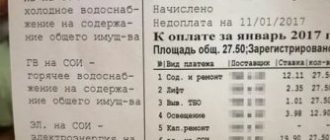Light, warmth, water - this is the comfort of our home. Saving money worries every resident of an apartment building.
Important! Today, many residents have thought about this and installed IPU - individual metering devices - in their apartments. These are electricity, heat, hot and cold water consumption meters.
It is necessary to take and transmit the IPU readings to the housing and communal services within the established time frame. Deciphering the items on the receipt is also necessary for consumers.
Methods for measuring the volume of consumed resources:
- Collective metering devices are installed for all residents of the house in the basement. All residents of the house pay for the resource consumption equally. The absence of some residents for a given period or the overuse of resources by others is not taken into account. Equalization of payments does not suit many residents. Regulatory rates can be too high.
- Individual devices record the actual use of resources by the residents of each apartment. They significantly save money for thrifty owners.
Why do you need an individual meter?
House-wide meters have certain disadvantages, the main one being equalization. It's no secret that all people consume different amounts of resources. Moreover, this volume is often significantly less than what is established by the standard. Using an individual device, it is possible to determine the amount of resources actually consumed.
Also, common house meters do not take into account the number of citizens actually living in the apartment who come to visit or work. What is an IPU and what advantages does such a device have? After installing an individual meter, you can:
– pay exclusively for the resources you consume;
– do not provide a certificate of temporary absence of people living in your apartment for recalculation;
– do not pay for resources for those who are not registered, but actually live in your home.
Those who are wondering what an IPU is, need to know that this device is a means of real savings not only in consumed resources, but also in your finances. There is information according to which residents who install individual appliances receive significant savings compared to standard rates. In some cases, you can save up to 60% of money.
Who to contact for installation
The installation of the IPU is carried out by the organization whose resource is consumed. The technicians of these organizations are required to install their equipment in the homes they serve. Unverified entrepreneurs may carry out poor-quality installation. You should be wary of such companies.
Important! It is necessary to inquire in advance about the cost of services for installing the IPU and the possibilities of meter verification. Verification must be carried out within the established time frame.
To install the equipment, an application must be left at the organization's customer service department. Within the specified time frame, residents provide access to the apartment to the craftsmen. Residents of the apartment pay for installed equipment. Organizations can provide installments to pay for installation.
An easier installation can be done through a management company. They have established contacts with service companies.
Application in calculations of IPU readings submitted later than the deadline
It should be noted that in the case of a transition to calculation based on the average monthly consumption of a utility resource and a subsequent transition to calculation according to the standard, the provision of IPU readings by the consumer does not entail any recalculations. Recalculation in this case is not provided for by Rules 354.
The readings provided by the consumer, in this case, are taken into account as the initial readings of the IPU, used to determine the amount of payment for utility services in the billing period following the billing period in which the consumer provided information about the readings of the IPU. Rule 354 does not contain a norm that literally establishes the use of IPU readings submitted by the consumer as initial readings for calculation in the next period. However, from the totality of the provisions of Rules 354 it follows that the contractor is obliged to accept the IPU readings submitted by the consumer and is obliged to apply these readings in calculations, while recalculation for previous billing periods based on the IPU readings submitted in violation of the established deadline, Rules 354 do not provide for.
Sources
- https://oschetchike.ru/vody/odpu-v-kvitantsii
- https://FB.ru/article/144570/chto-takoe-ipu-effektivnoe-sredstvo-ekonomii-resursov
- https://o-vode.net/vodosnabzhenie/schetchik/vidy/impulsnye
- https://PoUchetu.ru/interesnoe/ipu-v-kvitantsii-zhkh
- https://vgkh.ru/articles/rasshifrovka_kvitancii/
- https://acato.ru/articles/20170227/raschet-pri-nepredstavlenii-pokazanij-ipu
Work on installation of IPU water
You should know the list of works that the organization will need to pay for:
- inspection of water pipeline risers, installation design;
- installation of water meters;
- installation of connecting valves, filters and dampers;
- checking the operation of the assembly unit and sealing it.
Important! After putting the meters into operation, you sign an agreement for their annual maintenance. Payment is made for checking the integrity of seals, replacing or cleaning filters, and checking IPU readings.
How to measure the amount of resources consumed
Consumed resources can be measured in two ways:
- collective - when meters are installed to calculate electricity, water, gas or heat for an apartment building as a whole, with subsequent division of readings in equal shares depending on the number registered in a given living space;
- using IPU - an individual meter is installed in a separate apartment. As a result, residents pay only for actually used resources according to established tariffs.
With the collective accounting method, the consumer is forced to pay his share, regardless of his own consumption volumes. Even if no one lived in the apartment for some time, this does not relieve the obligation to pay and does not reduce the size of the invoice.
When using an IPU, the payer has the opportunity to independently influence the amount of payment by saving resource consumption.
What to do with the readings taken
Once a month, within the terms under the contract, the consumer has the right to transfer the IPU readings to the housing and communal services. The contractor is obliged to take these measurements. Also, once every 3 months, a representative of the housing and communal services must check the provided testimony. Residents are required to allow an employee to access the meter for verification and further transfer of information for reconciliation. Reliable data will help you avoid errors in your utility bill. How you can submit information:
- through the Internet;
- government services portal;
- by phone;
- via terminal;
- through the management company.
The transferred readings should be kept for three years, and independent consumption records should be constantly maintained.
Important! If meter readings are not transmitted, then the calculated average value based on the readings of individual devices for the period of the last 6 months is entered in the receipt. In this way, the calculation is carried out only for 3 periods. If the transfer of information on consumption does not take place on time, then the calculation of utility bills begins according to the average monthly standard. There are no increases in the coefficient.
Abbreviations and amounts on the receipt are deciphered in the management campaign. Formulas are also provided there. If you do not pay bills on time under the contract, a penalty may be charged. Debts on utility bills lead to the apartment being disconnected from the general channel of the consumed resource.
What we pay for - deciphering the housing and communal services receipt
There are utilities, housing and additional (other) services. Utilities are the supply of utility resources to your apartment: water, electricity, gas, heat, etc. Housing services are services for the management of an apartment building, as well as the maintenance and repair of common property, which are provided to you by a management organization or HOA . Additional services are those that are not included in the main list of services; residents of the house make a separate decision about them at a general meeting. These are, for example, home security, video surveillance, concierge services, radio point, etc.
You may like => They are knocking out a plot of land from a father for his son’s debts. What to do?
A receipt for payment for housing and communal services is a payment document that contains information about the consumer of services (payer) and the provider of services, calculation of the amount of payment for each service provided, tariffs, volume of consumption and prices for each type of utility resource, data on debt, overpayment and recalculation, as well as reference data.
We deal with the receipt
The accounting equipment is installed, information is transmitted on time. Let's consider the contents of the receipt for payment for housing and communal services. Services are listed in abbreviations. Explanation of some abbreviations requires explanation.
Important! We find readings of the information we are interested in on the IPU or ITU - individual devices or metering points. Opposite them are the actual and estimated costs and units of measurement.
Each payer can independently calculate the amount to be paid and check the accruals.
Installation procedure
Individual metering devices are installed by resource suppliers. To do this, the consumer needs to prepare a corresponding application to the city gas, water utility or energy supply with the corresponding request.
Upon request, a specialist from the organization will be sent to install the meter. The device is purchased by the consumer independently or offered by the company, with the subsequent submission of an invoice to compensate for the cost of the product.
We recommend: Storage period for receipts for payment for residential complex services
Water supply
In an apartment equipped with a hot and cold water meter, the charge can be calculated using the formula:
Vsn=V*Tvsn,
Where
Всн – amount to be paid for water supply in the receipt;
V – volume of water consumed according to the meter;
Tvsn - the cost of 1 m3 according to the local standard established by the local administration.
Let's look at an example. You have consumed a volume of 6 m3. According to the local tariff, 1 m3 of water costs 31 rubles. 6 m3*31 rub.=186 rub. It remains to compare this figure with the accrued amount.
Unique accrual identifier in a payment order - 2021
However, this provision does not affect all payments. For example, voluntary tax transfer based on calculated declaration data does not require indicating the UIN. Such a payment is determined on the basis of the KBK, and the details of the payer, whether an individual or a legal entity, are identified using the INN and KPP. The same applies to other fund transfers. The identifier is also not used in such cases.
You may like => Ultrasounds to Annoy Neighbors
When a tax debt arises, citizens may receive a receipt from the Federal Tax Service with the amount of payment due. In such cases, the UIN is already present in the document as an index. You can also generate a receipt for payment yourself on the Federal Tax Service website - then the index will be reflected in the document automatically.
Water disposal
Explanation of receipt items and payment methods is relevant for consumers. In apartment buildings, the drainage system is also paid for. Not all consumers know the definition of this concept. The system includes a whole range of measures from waste water disposal to treatment and disposal. The calculation will be based on the established sewerage tariff. But the device will help calculate this indicator:
- In answer = (V hot + V cold) * T here,
- In otv - the amount for sewerage;
- V hot – volume of hot water;
- V cold – volume of cold water;
- T votv – water disposal tariff.
When using cold and hot water meters, you should not forget that you must use the appropriate taps. Utility tariffs for cold water are lower.
How to choose an IPU
The modern market offers customers a huge selection of different meters for all types of resources, both domestic and foreign production. When choosing a product, the following circumstances must be taken into account:
- purpose of the device - when choosing a water meter for an individual apartment, consumption indicators, degree of protection, nominal diameter and connection of fittings, and other installation dimensions are taken into account. When selecting an electric meter, you should pay attention to the characteristics of the electrical network, the total power of the household appliances involved to ensure compliance with the permissible parameters of the device. A similar analysis is necessary for IMP for measuring other resources;
- passing certification in Russia for compliance with safety requirements and metrological standards - if the product has not passed the specified procedure, its use on the territory of the Russian Federation is not permitted;
- degree of measurement accuracy - these data are indicated in the IPU passport;
- standard service life - the longer this indicator, the longer the device will last and you will not have to spend money on purchasing a new meter to replace the old one;
- frequency of verification - depending on the design, workmanship and other factors, the manufacturer sets a period after which the product must be verified by an accredited organization. The specified work is carried out at the expense of the consumer and in most cases is associated with the need to dismantle the device in order to submit it to a calibration company, therefore it is in the interests of the owner to choose a device with a long verification period.
The price of the product plays an important role. But before making the final choice of a device, it is recommended to first consult with a representative of the relevant utility organization so that the purchased product meets the necessary requirements and there are no problems in the future regarding the possibility of its use.
How to choose a gas meter:
How to choose an electricity meter:
How to choose a water meter:
What is thermal energy in the housing and communal services bill?
This term refers to the cost of heating cold water. It was already mentioned above that the calculation of hot water supply consists of two parts, one of which includes such a value as “thermal energy”.
The amount to pay for this service is calculated taking into account the following components:
- thermal energy tariff;
- expenses required to maintain a centralized hot water supply system;
- cost of thermal energy loss in pipelines;
- costs necessary to transport hot water.
The amount of thermal energy is determined based on general house values.
Now, after reading this article, you don’t have to worry about utility bills, because you know how the standard abbreviations stand: KPU, IPU, ODN, Gcal, ODPU, DPU.
If you find an error, please select a piece of text and press Ctrl+Enter.








